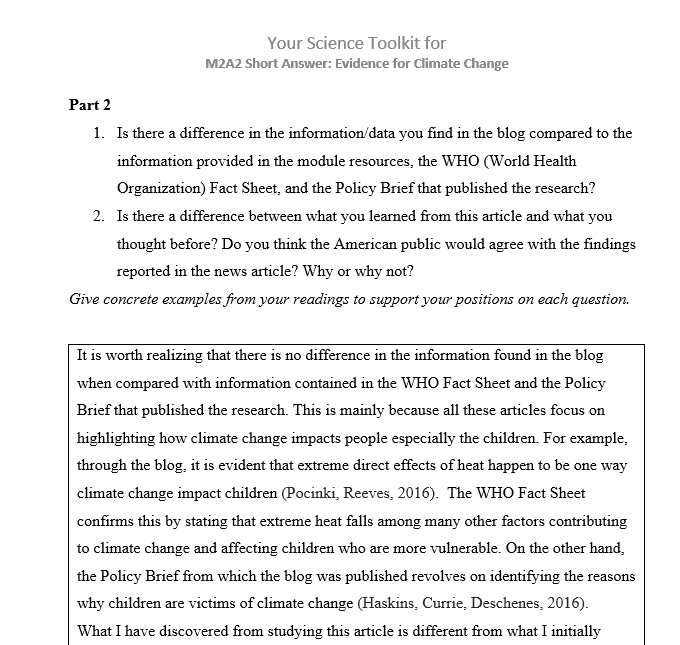There are many different factors that must be considered when we discuss the impact of climate change around the world
M2A2: The Impact of Climate Change on Health
Scientists are able to make very accurate predictions about the amount of temperature change that will occur due to future greenhouse gas emissions. Using computer models, scientists are also able to predict how increments in temperature change will impact the world around us. Often the way things are phrased in a news source can sensationalize a topic beyond what the scientists’ research actually suggests. Reporters want to grab our attention and impress us with the importance of the findings in the research, but this approach can turn possible outcomes into a sure thing just by changing a few words. There is a big difference in the prospect of an event occurring depending on whether it is likely, possible, or certain. Watch for these terms in reading the materials provided for this and future assignments.
There are many different factors that must be considered when we discuss the impact of climate change around the world. This activity will focus on the challenging idea of how climate change will affect the health of our children. Children’s health is most vulnerable to small, incremental changes, and our children will be dealing with the results of climate change long after we adults are gone. The shifting of rain and drought patterns, the range of temperature changes, and the resulting changes in plants, insects, and animals—the global environmental zones will be in flux over the next century. The readings here will discuss these changes and how scientists predict they will affect the health and well-being of our children.
Completing this activity will assist you in mastering Module Level Outcomes 2 and 3.
First, read the following:
WHO Climate Change and Health (Links to an external site.)Links to an external site., Fact Sheet 266 (updated 9/2015)
Pocinki, A., Reeves, R.V. (2016). The world’s children are already suffering from climate change (Links to an external site.)Links to an external site. . Brookings Blog, Social Mobility Memos, Brookings Institute
Haskins, R., Currie, J., Deschenes, O. (2016). Children and Climate Change (Links to an external site.)Links to an external site. [PDF file size 1.6 MB], The Future of Children, Princeton-Brookings, Policy Brief, Vol.26 N.1 Spring 2016 (This is a large report, you should read pages 3-9 for this assignment)
Next, submit the following:
A completed M2A2 Your Science Tool Kit (download M2A2 STK template
Solution preview for the order on There are many different factors that must be considered when we discuss the impact of climate change around the world
APA
1697 words
